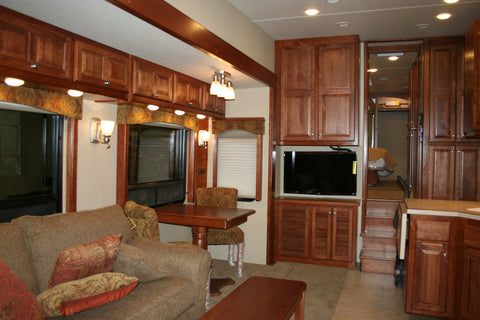RV Types
Class A Class B Class-C
Fifthwheel
Travel Trailer
Safety Issues
The fifth wheel type of trailer has been used in the trucking industry for almost 100 years because it is a safe way of carrying heavy loads. It's safe because the hitch configuration allows the trailer to be attached over the truck's rear wheels. Because of its forgiving nature to road and driving conditions, commercial truckers use the fifth wheel hitch configuration to carry extremely heavy loads. A fifth wheel trailer will stick to the tow vehicle through thick and thin. In many adverse handling situations, a fifth wheel trailer will actually enhance the ability of the tow vehicle to stick to the road. Whether in tractor-trailer rigs or in travel trailers, the fifth wheel configuration is popular because of its safety and handling capabilities.
Easy to Use
A fifth wheel trailer is especially popular with fulltimers because most of these RVers want to go as big as the towing vehicle will allow. The fifth wheel is easy to connect and disconnect from the truck. It's relatively easy to back up. Its tendency to sway is much less than that of a trailer coach. Because it can easily carry more height, it allows for more storage space - something every fulltimer wants.
Eyecatchers of a Fifth Wheel
|

Fifth wheels have transformed full-time living on the road into a more pleasurable experience offering plenty of comfort, convenience, and safety
|

Living Room Slideouts in a fifth wheel provide a roomy atmosphere, but the quality of slideout mechanisms vary with each manufacturer.
|

As fifth wheels get bigger and heavier, the need for a larger truck increases - adding to the already hefty price tag of the fifth wheel.
|
What You Need
Now that we've gone through a litany of praises for the fifth wheel trailer, let's look at the big picture with a bit of objectivity. Fifth wheel trailers are not for everyone. For one thing, you must have a truck to pull a fifth wheel. You cannot hook it onto a van, a sedan, or a pickup with a canopy. You cannot generally pull another car behind it. You cannot generally pull a boat behind it. You cannot generally let the family ride in it as you go down the road. These are very important limitations for some people.
Too Easy to Build
Because of the number of retired people who have taken up fulltiming, many large and small RV builders are specializing in fifth wheels from 30 to 45 feet in length. Some of these manufacturers have become very rich turning out crackerboxes of that size. Right now there are dozens of brands being produced that will not last 5 years without serious deterioration and severe frustration for the users. In addition to this problem, there are quite a few relatively good manufacturers who are cutting corners on quality in places where the cuts are not easily seen because they feel they need to compete with the crackerbox makers. Some manufacturers also cut corners to reduce the overall weights and hitch weights of their large models to make them towable by pickups.
Weight Issue
That brings us to the most serious issue with fifth wheels — size and weight. The towing and carrying capacities of pickups have increased greatly over the years, enabling them to pull larger and heavier fifth wheels than ever before. The question is now, "Should they?" Loss of control may become a serious problem for ordinary pickups, with their relatively short wheelbases and low curb weights. In other words, we may begin to see more of the dangerous "tail-wagging-the-dog" behavior that is already common with trailer coaches.
Perhaps the answer is to use a larger tow vehicle. For example, if you buy a 40-foot trailer with four slideouts and all the luxuries of home, a medium-duty truck (MDT) should pull it safely and reliably. But do you really want to drive and park a nearly 60-foot long, 8' 6 wide, 30,000-pound truck-and-trailer combination?
An obvious common-sense solution for most RVers is to simply choose a smaller, well-built trailer that can be towed safely and reliably by any large pickup. For pointers on selecting the proper truck to tow your trailer, see the How to Tow Safely Guide.
Closing Thoughts
This introduction to fifth wheel travel trailers should be just the beginning of your research into techniques for choosing and using. We encourage you to begin your studies with the RV Ratings Guide
We hope that you, as a member of RV Consumer Group, will contribute by sharing your experiences and observations. Making RVing safer and better always begins with you.




